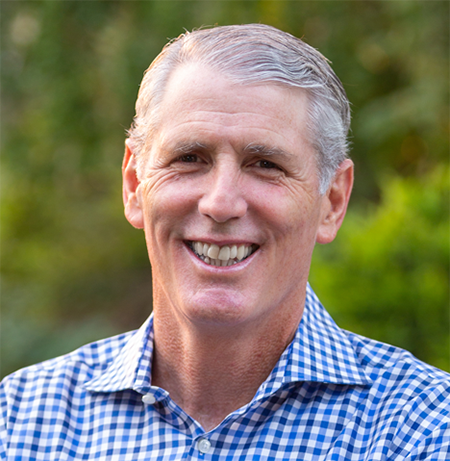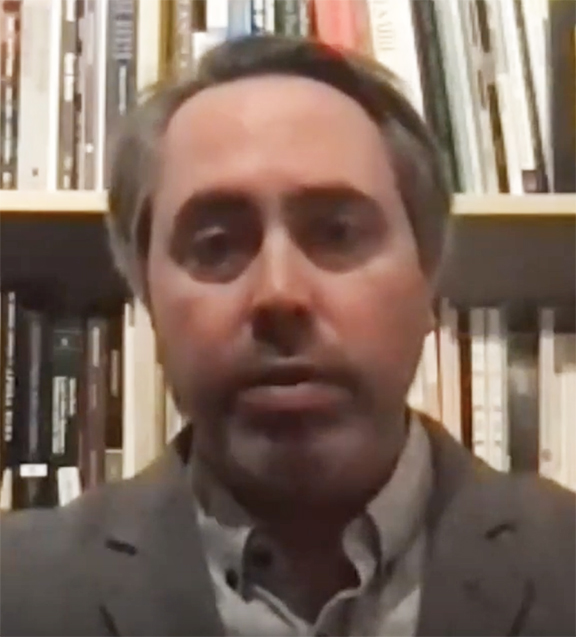Working during a pandemic
What’s it like to work in-person this Fall?
Faculty members share their perspectives on returning to F2F teaching and counseling this semester
by Katharine Harer, AFT 1493 Co-Vice President
As most faculty look ahead to a full return to in-person instruction in January, The Advocate wanted to learn more about the experiences of some of the few faculty who have been working on campus this semester. We were able to gather responses to a short set of interview questions from four faculty members: Martin Bednarek, Counselor at CSM; Todd Windisch, ESL at CSM; Rachel Cunningham, Geography at Skyline and Rob Williams, English at Skyline.
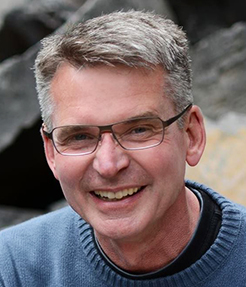
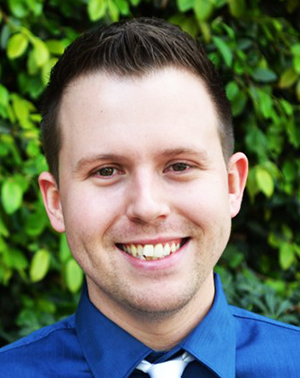
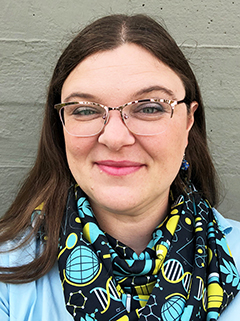

Martin Bednarek, Todd Windisch, Rachel Cunningham and Rob Williams have all been working on campus this semester
Their answers to our questions were frank and thoughtful, illuminating, and, at times, surprising. Each of us works and meets with students in different spaces. We utilize different strategies, depending on our subject matter and our duties. But given those differences, we think you’ll find that this is an informative snapshot of what some of our colleagues are experiencing on our campuses.
As we get closer to returning for the Spring semester, and as our union works to negotiate a new MOU and actively support the advocacy of our reps on campus Health & Safety committees, it’s enlightening to hear from colleagues who are there, on the ground, right now.
Note: Since Todd is teaching a class in hyflex mode for the first time, we asked him to describe a few more details about his unique experience. His brief story of teaching a hyflex class is included in a separate section at the end of this article.
Here are the questions we asked and your colleagues’ responses:
What were some of your concerns/fears before starting the semester and how did things play out?
Knowing that it is impossible to maintain six feet of distance between myself and a student in my office, I was (and still am) concerned about health and safety for myself and for my students. In-person Counseling at CSM started a few weeks ago, and admittedly I was anxious about the lack of distance. The delayed process for how students would attest that they are eligible for in-person services did not help. Although I am fully vaccinated, I’m still not convinced that the lack of social distancing, the air-quality in our offices, the confusing attestation process roll-out and regular sanitizing of our areas will keep me safe. (Martin Bednarek, CSM Counselor)
Honestly, I didn’t think we’d make it through the semester without having to go back to shelter in place. I had one week where I had my students attend online lectures while I was waiting for my negative Covid test results (just a nasty cold!) and no instruction time was lost. I continuously emphasize to my students not to come to class if they’re not feeling well and that everything can be made up. In many ways, bracing myself for the worst made all the small hiccups (colds, student attendance) go much smoother. My other big fear was about our low enrollment – I feel better knowing that enrollment is down across the entire state, but these small numbers do make my heart lurch. On the plus side, my students get much more focused attention! (Rachel Cunningham, Geography, Skyline)
I was less concerned about infection than I was about being able to teach and communicate while wearing a mask. A key element of teaching is non-verbal communication, such as smiles and other facial expressions. I was worried that with everyone wearing a mask we wouldn’t be able to understand each other, or that students would be distracted, wouldn’t be engaged, and that this might make learning difficult. To be honest, this is probably the hardest part. It’s not easy to hear students when they are responding in class. I often have to ask them to repeat their answer, or ask their question again– always kindly, of course. It’s not a major issue, though.
I was also concerned about the amount of students and the size room we were assigned. The class was full — 26 students — and we were assigned one of the classrooms on the 2nd floor of Building 8. Even in ‘normal’ times, these rooms are small and cramped with a class of 26. However, I emailed my dean and within an hour he had found a new room for us– on the 3rd floor of Building 8, one of the large rooms with several windows and a door to an outside patio. (Rob Williams, English, Skyline)
I had some concerns about mask use and vaccination requirements because some of the communication leading up to the semester was so vague. The college was saying vaccinations were required for students, but there were no systems in place to verify students’ documentation. I didn’t know how to convey the so-called requirements accurately in my syllabus or in class, and I wasn’t sure how well students would comply with mask mandates. I found that students have been very good about wearing masks and social distancing in class, but due to the college’s lax stance on vaccination status for this semester, I know for a fact that I have at least one student attending regularly in-person who is unvaccinated. I have no issue with it, though, since everyone is wearing masks, disinfecting their desks, and social distancing. (Todd Windisch, ESL, CSM)
What has surprised you about working in-person this semester?
I had fully been psyching myself up for having to deal with a student refusing to wear a mask or having a big outburst about mask mandates in class from a student, some sort of political statement. I’ve had to remind students to wear their masks properly, but no one has been belligerent about it. (Rachel Cunningham, Geography, Skyline)
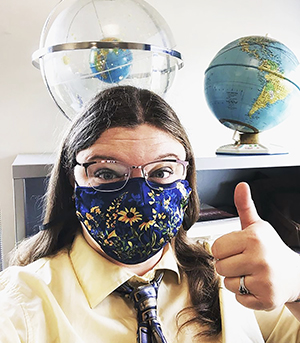 Rachel Cunningham in a mask
Rachel Cunningham in a mask
I am surprised that more students are not on campus. The District seems to believe that the majority of our students want in-person classes and services even though many students have found remote learning and services to be the best way, and perhaps the only way, for them to complete their education. I will say that I was surprised that I was a bit freaked-out the first day of in-person counseling. Now I’m more comfortable, yet every time I walk a student back to my office, I’m reminded that it is impossible to maintain six feet of distance between us. (Martin Bednarek, Counseling, CSM)
I shouldn’t be, but I was surprised how much I missed being around people. The energy I get from teaching in front of live bodies instead of black screens made this semester much more enjoyable than the last and has created a sense of community that I missed in my classes. Being in my office every day and keeping a regular work schedule again has also helped me develop a healthier work/life balance. (Todd Windisch, ESL, CSM)
What surprised me is how few faculty came back! I was expecting more of my colleagues to come back. I’m not sure why I thought that. It turns out, though, that I was just one of three English faculty on campus — and two were part-timers from another college. Not even our part-time faculty wanted to return to campus.
To be honest, one of the main reasons I came back was to see my colleagues again. I miss them. You don’t realize how much you depend on and look forward to the interaction with your colleagues and friends. Stopping by their office to say hello or to commiserate, or to ask about their family, their dog. Even a smile in the hallway. It’s so crucial to our mental and emotional health. Those daily interactions that we take for granted. It didn’t really hit me until the 2nd semester we were at home, but when it did the loss was so profound. (Rob Williams, English, Skyline)
How cooperative have students been regarding Covid rules, requirements, etc.?
I believe our students have similar concerns about their health and safety and will cooperate if they know what cooperating means. I have no idea how rules and requirements are being enforced. The campus is wide-open, students, faculty and staff freely come and go. The attestation process was rolled out in bits and pieces, and although it is now in place it isn’t clear who or how we deny a student in-person services, including Counseling, when they come to campus and show up in Building 10 on the third floor at CSM. But I will say that I’ve not seen anyone without a mask. (Martin Bednarek, Counseling, CSM)
The overwhelming majority of the students have been awesome. I do have one or two students who have the “nose slip” often, but are quick to fix it when I point it out. It is frustrating to have it be the same students I have to remind to fix their mask over and over again, but I am thankful it’s such a small number. In fact, I would say that most students have voluntarily been extra Covid cautious – I give students the option to work in socially distanced groups or individually, and almost all chose individually. I’m seeing more glove usage when we have plant or rock samples in class – if I just suggest “Oh, you can wear gloves if it makes you feel safer,” several students will immediately take me up on it. Also, I ask all students to sanitize the shared classroom lab supplies when they’re done with them, and they’ve been great about doing that. (Rachel Cunningham, Geography, Skyline.)
Students have been amazing! That’s another thing that surprised me. I was worried students might not wear their masks, or that they might be rude or cold to each other given the heightened stress and anxiety we are all feeling. Everyone is so kind to each other, and the students are so gracious. If they are there, it’s because they want to be there. Students have no problems wearing their masks. There was one student one day whose mask kept slipping below his nose and sometimes down to his chin and another student quietly mentioned it to me. I just made a quick, friendly announcement to everyone to make sure your masks are secure, and the student fixed his mask. There have been no issues at all. (Rob Williams, English, Skyline)
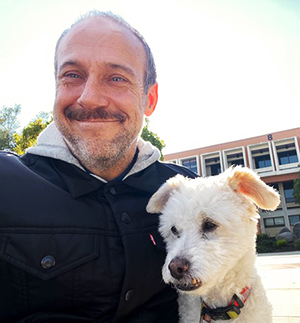 Rob Williams with his dog, Hal, on the Skyline College campus
Rob Williams with his dog, Hal, on the Skyline College campus
ESL might be a unique population, and my in-person class is relatively small since it’s hyflex and a lot of students attend online, but my students have been very cooperative with the COVID rules of the class. It took some coaching in the first week, but as students walk into the class, they all grab a sanitizing wipe and clean off their desks; they sanitize their hands with the hand sanitizer (I have four bottles provided by the college around the classroom), and they take their seats and keep their masks on the whole time. Of course, there’s the occasional student whose mask falls down below their nose or who will try to sneak a drink of water or some food during class, but with a gentle reminder, they have all been very receptive in addressing the issue. (Todd Windisch, ESL, CSM)
What improvements would you like to see the college/district make by next semester?
I would like the college/district to make sure that classes aren’t overfilled and to not require us to take on extra students. It would be helpful if we could lower the class maximum to 20-21 students. Again, the classrooms, especially on the 1st and 2nd floors of Building 8 are not big enough for 26 students to have enough space. Some of the classrooms on the first floor don’t have windows (that open, anyway). I understand that we are not mandated to stay ‘Six Feet Apart’ but it does give some comfort and ease some concerns to have extra space/more room in the classroom. (Rob Williams, English, Skyline)
I’m happy the college is implementing a vaccination requirement and system for evaluating exemptions, but I have worries about the implementation. I have been reminding students in my classes now to make sure they upload the documentation they need now, but I am worried some students will miss that step and end up getting dropped at the beginning of next semester. A lot of students don’t check their e-mail regularly, so I think the college really needs to make this extra registration step extremely clear across WebSchedule and WebSMART. (Todd Windisch, ESL, CSM)
I would really love for free rapid testing to be available to anyone who asks for it. We know people who are vaccinated can still get Covid, we know people who are asymptomatic can still spread it. It would just be better for peace of mind. I’m currently rapid testing at home before I go to social events with vulnerable people. (Rachel Cunningham, Geography, Skyline)
When the pandemic started in March, 2020 and we began to operate remotely, our District quickly responded to the needs of students, faculty and staff. Even though it was difficult and the learning curve was steep, the District provided resources, training and accommodations efficiently and generously. Faculty and staff learned to be effective and our students continued with their education. We did good!
Now that the pandemic may be waning, I don’t think returning to campus as quickly as we left is the best strategy. I hope we will be able to maintain what has worked. None of our colleges are easy to get to and students who had difficulty getting to campus have been regularly showing up for remote classes and appointments. We need to maintain enough remote classes and services to continue serving those students. I hope faculty who have remote classes and remote counseling appointments are not forced to work remotely from their offices. It is bad for the environment, bad for morale and bad for work/life balance. (Martin Bednarek, Counseling, CSM)
Are supplies, such as masks, easily accessible for students who need them?
Yes, there are large pump bottles of hand-sanitizer in the classrooms, and if there isn’t you can request one. I also received a box of masks. Both of these are placed at the entrance to my classroom. Students use the hand-sanitizer regularly. (Rob Williams, English, Skyline)
So far, I have seen several mask and hand sanitizing stations in Building 10. I’m not sure about the rest of the campus. (Martin Bednarek, Counseling, CSM)
Yep! My dean, Dr. Porter, dropped off a box of gloves and a box of masks on the first day of class, and we are still good! The automatic sanitizer dispensers in the building are sometimes empty – not sure if it’s because of high demand or if they are being refilled less frequently. (Rachel Cunningham, Geography, Skyline)
Masks are always available for students at our division office, and sanitation equipment has been kept in stock in my classroom, so I’ve had no issues with supplies this semester. (Todd Windisch, ESL, CSM)
Are your classrooms, office and meeting spaces as safe as you’d like them to be (ventilation, room to socially distance, etc.)?
My enrollment is so low that my students are able to all have their own little island with their desk! However, my classroom has no windows – currently I leave both the doors propped open for ventilation but that’s not the best for noise levels. The thought of 45 students in my classroom – that’s every seat taken – and no windows to open does unnerve me a bit. Meetings in my office with students (windows do not open) also unnerves me a bit, but I don’t see any way around that. (Rachel Cunningham, Geography, Skyline)
Absolutely not. Supposedly, someone verified that the air-quality in my office meets regulations. Our offices are small and we see students back-to-back all day long. Students sit 3-4 feet from us, and even though I’ve been keeping the office door open now, it is not an appropriate way to maintain confidentiality. I do not see evidence of daily sanitizing of my office or the Counseling Division area. (Martin Bednarek, Counseling, CSM)
I have felt very safe on campus this semester. This may come from the low number of people on campus (my officemate hasn’t been on-campus, for example), and everyone I see has been masked and social distanced. I can keep my window and door open in my office, I have a small fan to keep the air flowing, and classrooms and public spaces don’t feel crowded at all. (Todd Windisch, ESL, CSM)
It does seem as if the ventilation is better– in fact, some of the rooms, and especially my office, are too cold, as if cold air is constantly being piped in. As I mentioned previously, right now my room is large enough that students can spread out comfortably and have their own space, but I am concerned that this won’t happen in the spring, especially if they keep the class size for English at 26. There are only a few large rooms in Building 8. (Rob Williams, English, Skyline)
And a final comment:
Overall, I am so thankful to be back teaching in-person. I was going stir-crazy at home, and I thrive off of student interaction. I’ve definitely had to make some shifts in how I teach – for example, I had a group activity that bombed because a) there were hardly any students; and b) none of the students wanted to interact with each other. “Turn to your neighbor and discuss” is a lot harder when your neighbor is 6 feet away. Much of my lab class is hands-on, so I’ve had to re-write some sections (bye-bye play-dough landforms) and use gloves a lot more often (can you sanitize rocks?). I’ve tried to take the students outside more – mainly because we have this amazing outdoor classroom with rock and plant samples, but also to get more air. (Rachel Cunningham, Geography, Skyline)
We want to thank the four faculty members who took the time to share their thoughtful responses. We hope that their experiences and observations will be instructive to you as we prepare for spring. Your union will continue to advocate for the strongest protections for all faculty as we enter this new chapter together.
—————————————————————————————————————-
A Hyflex pioneer: First-time experiences teaching in-person and online simultaneously
Todd Windisch, ESL, CSM:
Since I’m teaching a Hyflex class, I was concerned about how I would manage the technology and engage my in-class students and online students simultaneously. Leading up to this semester, it still wasn’t 100% clear what kind of technology I’d have access to in my classroom, but about a week or two before the semester began, my dean set up a meeting with me and another ESL professor teaching Hyflex, handed us the 360 degree camera we’d be using, and gave us time to test our classrooms out. I was under the impression we’d have more hardwired technology, and the webcam felt like a ‘quick and dirty’ solution at the time, but it ultimately worked out fine. The camera audio and video quality are good, and students have told me they feel engaged, whether they choose to attend online or in-person. I’m teaching the same class in the same modality this spring, and I’m hoping that I’ll have access to one of the upgraded Hyflex classrooms that the college has mentioned should be available, but if I have to use the same technology, I can make it work.
 Todd teaching in hyflex mode
Todd teaching in hyflex mode
I was surprised at how useful the Hyflex model has been for some students. I had one student this semester who was attending mostly in-person, but she was exposed to COVID and had to quarantine for two weeks. The Hyflex model allowed her to continue participating and not miss a beat while following steps to keep her and her classmates safe. I also had an international student who had delays in getting her visa approved, so she was able to take the class online for the first few weeks, and then come in-person once she arrived.
I must admit, though, that I wish more students would come in-person. My in-person percentage started strong at the beginning of the semester (about 50/50), but at this point I usually only have about 5-6 students in-person, and the other 16 or so participate online.
I was definitely thankful for the additional units this semester to prepare for my hyflex class, which takes more effort to prepare than a strictly in-person or online class. I used the time at the beginning of the semester to get comfortable with the new technology I was using and to get to class early to set up. It also gave me extra prep time to plan my lectures in a new format. For example, for in-class group activities, I had to create both online Google Doc activities for the Zoom students to collaborate on and printed handouts for in-class students. I was also able to create asynchronous grammar review videos to supplement my live lectures, giving students more flexibility in their schedules.


